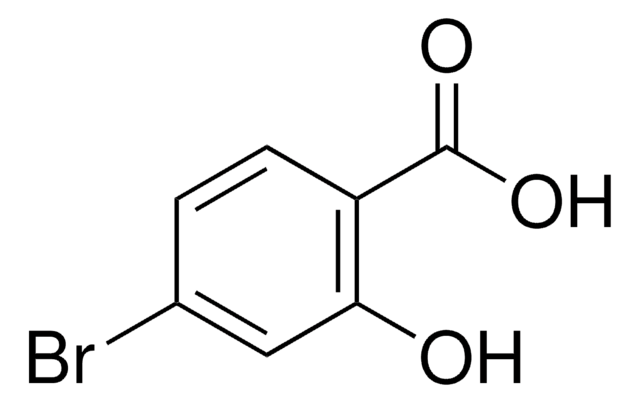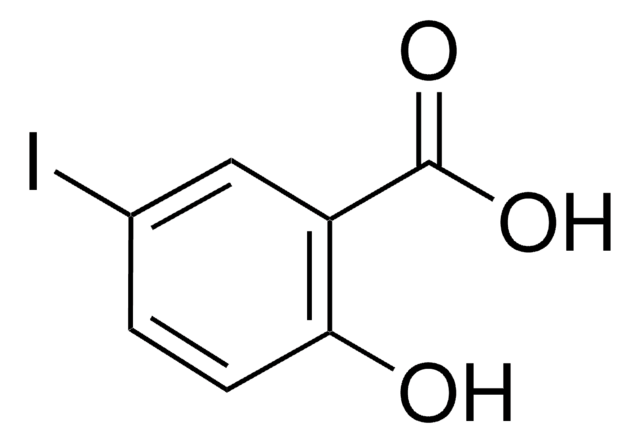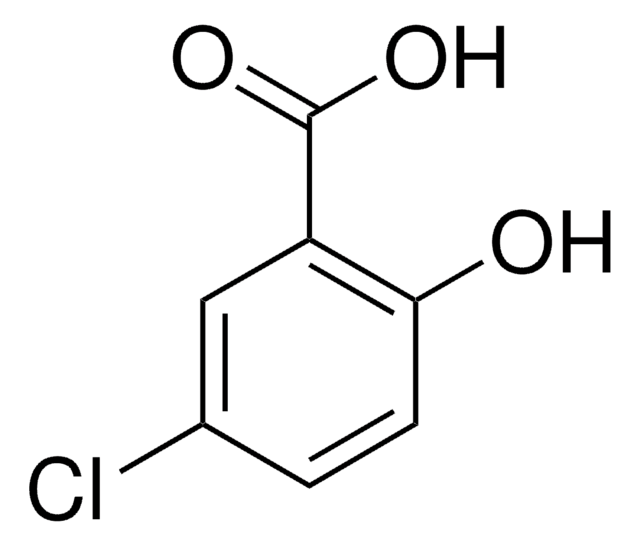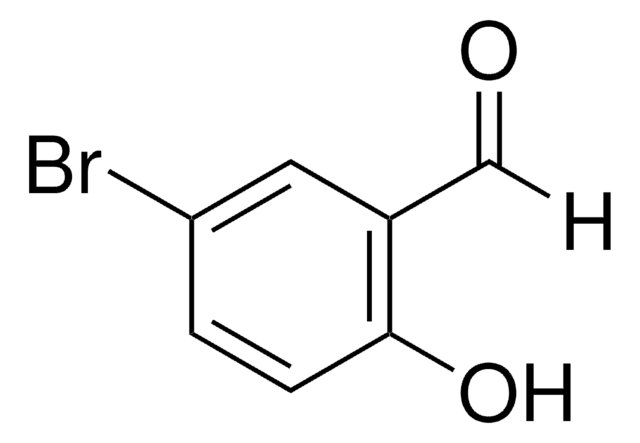461814
5-Bromosalicylic acid
technical grade, 90%
Synonym(s):
5-Bromo-2-hydroxybenzoic acid
Sign Into View Organizational & Contract Pricing
All Photos(2)
About This Item
Linear Formula:
BrC6H3-2-(OH)CO2H
CAS Number:
Molecular Weight:
217.02
EC Number:
MDL number:
UNSPSC Code:
12352100
PubChem Substance ID:
NACRES:
NA.22
Recommended Products
grade
technical grade
Assay
90%
form
solid
mp
159-162 °C (lit.)
SMILES string
OC(=O)c1cc(Br)ccc1O
InChI
1S/C7H5BrO3/c8-4-1-2-6(9)5(3-4)7(10)11/h1-3,9H,(H,10,11)
InChI key
IEJOONSLOGAXNO-UHFFFAOYSA-N
Looking for similar products? Visit Product Comparison Guide
Related Categories
General description
5-Bromosalicylic acid is a salicylic acid derivative. Its bonding to viscose fabric can impart antibacterial properties to the fabric. It has been identified as one of the brominated disinfection byproduct (Br-DBP) formed during the chlorination of saline sewage effluents.
Application
5-Bromosalicylic acid may be employed as a starting reagent for the synthesis of honokiol, a biphenyl-type neolignan.
Storage Class Code
11 - Combustible Solids
WGK
WGK 3
Flash Point(F)
Not applicable
Flash Point(C)
Not applicable
Personal Protective Equipment
dust mask type N95 (US), Eyeshields, Gloves
Certificates of Analysis (COA)
Search for Certificates of Analysis (COA) by entering the products Lot/Batch Number. Lot and Batch Numbers can be found on a product’s label following the words ‘Lot’ or ‘Batch’.
Already Own This Product?
Find documentation for the products that you have recently purchased in the Document Library.
Customers Also Viewed
Benjamin Foerster et al.
ACS nano, 11(3), 2886-2893 (2017-03-17)
Metallic nanoparticles show extraordinary strong light absorption near their plasmon resonance, orders of magnitude larger compared to nonmetallic nanoparticles. This "antenna" effect has recently been exploited to transfer electrons into empty states of an attached material, for example to create
Ammar Ebrahimi et al.
Talanta, 189, 592-598 (2018-08-09)
The new sensitive diagnostic method, electrochemical nanobiosensor, is applied to cancer detection by using specific biomarkers such as miRNA. Studies have shown that for the diagnosis of Triple Negative Breast Cancer (TNBC) patients, in the early stages of the disease
Kizuku Shibata et al.
The Journal of chemical physics, 152(10), 104706-104706 (2020-03-17)
Metallic nanogap dimers are extremely useful for enhancing surface-enhanced Raman scattering and various nonlinear optical effects employing near-field enhancement effects induced by the localized surface plasmon resonance. However, the metallic nanogap dimers exhibit an intense light scattering due to the
Kang Liu et al.
Chemistry (Weinheim an der Bergstrasse, Germany), 23(14), 3291-3299 (2017-01-12)
Gold nanorods (AuNRs) are versatile materials due to their broadly tunable optical properties associated with their anisotropic feature. Conventional seed-mediated synthesis is, however, not only limited by the operational complexity and over-sensitivity towards subtle changes of experimental conditions but also
Jian Zhu et al.
Spectrochimica acta. Part A, Molecular and biomolecular spectroscopy, 236, 118343-118343 (2020-04-18)
Au@AuAg yolk-shell nanorods with tunable and uniform interior gap were synthesized through galvanic replacement reaction, where Au@Ag core-shell nanorods served as sacrificial templates and HAuCl4 solution served as reductant. The effects of HAuCl4, Ag shell thickness and aspect ratio (AR)
Our team of scientists has experience in all areas of research including Life Science, Material Science, Chemical Synthesis, Chromatography, Analytical and many others.
Contact Technical Service














